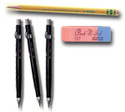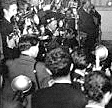A Humanistic Discipline
At The Catholic University of America, the Department of Media Studies will provide you with tools for analyzing critically the forms and contents of contemporary mass media and give you basic opportunities to compose your own texts in various media.

The foundation of Media Studies at CUA comprises a carefully designed balance of innovation and tradition. Core courses emphasize the study of film, television, the Internet, and related media in various aesthetic, social, and cultural contexts; these required classes employ methods of analysis from the canons of rhetorical and historical criticism across the humanities.
Our commitment to the liberal arts means that these courses emphasize writing and critical thinking: instructors and writing specialists work one-on-one with you, both within the classroom and without.
A Disciplined Approach
Media mediate. Between friends, between nations, between ideologies, between centuries: Media exist in the in-between. The alphabets we use, the gestures we make, the colors we choose, the languages in which we speak. There is always something between us.

It is difficult to overestimate the roles media play in our lives-and in the lives of our cultures. They establish communities, enable political discourse, facilitate economies. Media become tools of both oppression and resistance, of both entertainment and enlightenment.
In introductory courses, Media Studies emphasizes the value of critical distance. Critical distance affords the writer a glimpse of the hidden machinations of political and commercial rhetoric. Students work to disengage themselves from the whorl and blur of media around them, from the constructs and habits that often shield us from the world beyond our own im-media-te experience.
Literary Models
The rhetorical triangle (below) is a simple theoretical construct popularized earlier in this century by literary scholar M.H. Abrams in The Mirror and the Lamp. The diagram serves as the methodological backbone for MDIA 201, the first of the core Media Studies courses at Catholic University. It provides students with a broad framework within which they can develop their abilities as independent readers, writers, and critics.

The model suggests that there are three major categories of criticism. Rhetorical theories of criticism emphasize how a text manipulates the audience. An essay in the rhetorical mode might argue, for example, that "Spielberg's film Arachnophobia is a ninety-minute exercise in our collective-and often hysterical-fear of spiders". The second group, mimetic theories, probe how closely a text reflects the world: "While ancient stories featured the actions of gods, Kings, Dames and Dons, Modernity's belief in Realism gave us novels about the godless, the poor, the debauched and the drunk". Expressive theories, the third group, focus upon the author and his relationship with his creation. An article using expressive criticism might suggest that "While his movies range widely in location, characters, genre and story, Woody Allen's films are finally really only about one thing: Woody Allen."
Theory and Practice
As your writing matures, you will begin to experiment with other media. By engaging you both as critic and creator, your critical awareness and analysis of cultural texts becomes even more sophisticated: a working knowledge of how photographs are manipulated, how a web page is designed, how a 30-second TV spot is composed means you are not limited to talking about media.

Courses in both the theory and the practice of media production take advantage of our growing Media Lab. Hands-on instruction includes courses in traditional and digital photography and videography, design aesthetics, digital imaging techniques, and digital video editing. Students who choose to pursue advanced media production may take courses in which they produce complex and sophisticated film shorts.
Read more about media and texts
